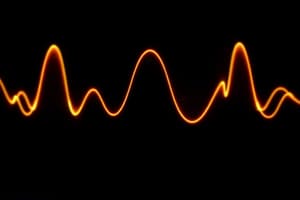Podcast
Questions and Answers
What is the primary characteristic of a zinc-air battery that makes it suitable for portable devices?
What is the primary characteristic of a zinc-air battery that makes it suitable for portable devices?
- Wide temperature range
- Lightweight design (correct)
- Rechargeability
- High power output
Which of the following types of sensors measure voltage instead of current or conductance?
Which of the following types of sensors measure voltage instead of current or conductance?
- Amperometric sensors
- Potentiometric sensors (correct)
- Electronically simulated sensors
- Conductometric sensors
In polymer chemistry, which of the following correctly describes the process of polymerization?
In polymer chemistry, which of the following correctly describes the process of polymerization?
- Combination of monomers to form polymers (correct)
- Separation of polymer chains into oligomers
- Formation of monomers through reduction
- Decomposition of polymers into monomers
Which of the following best describes the nature of electrolytic cells?
Which of the following best describes the nature of electrolytic cells?
What is a common limitation of absorption laws in analytical chemistry?
What is a common limitation of absorption laws in analytical chemistry?
What type of polymerization involves the formation of by-products alongside the polymer chain?
What type of polymerization involves the formation of by-products alongside the polymer chain?
Which type of chromatography would primarily separate compounds based on their vaporization characteristics?
Which type of chromatography would primarily separate compounds based on their vaporization characteristics?
What does the wave function Ψ describe in quantum mechanics?
What does the wave function Ψ describe in quantum mechanics?
In UV-Visible spectroscopy, what characteristic must a vibrational mode possess to be considered allowed?
In UV-Visible spectroscopy, what characteristic must a vibrational mode possess to be considered allowed?
What is the consequence of constructive interference of atomic orbitals in bonding molecular orbitals?
What is the consequence of constructive interference of atomic orbitals in bonding molecular orbitals?
How do anti-bonding molecular orbitals differ from bonding molecular orbitals?
How do anti-bonding molecular orbitals differ from bonding molecular orbitals?
What does the Nernst equation help calculate in electrochemistry?
What does the Nernst equation help calculate in electrochemistry?
Which of the following is a characteristic of Type II superconductors?
Which of the following is a characteristic of Type II superconductors?
What are the primary applications of carbon nanotubes?
What are the primary applications of carbon nanotubes?
What is the primary difference between diffusion and ion implantation?
What is the primary difference between diffusion and ion implantation?
Which equation is utilized to describe the energy of a particle in a one-dimensional box in quantum mechanics?
Which equation is utilized to describe the energy of a particle in a one-dimensional box in quantum mechanics?
Flashcards
What is Ψ²?
What is Ψ²?
Describes the probability of finding a particle in a specific location. It is the square of the wave function.
What is Ψ?
What is Ψ?
The wave function describes the quantum state of a particle. It captures information about its momentum and position.
What is a Bonding Molecular Orbital?
What is a Bonding Molecular Orbital?
These form when atomic orbitals overlap constructively, leading to lower energy and increased electron density between nuclei.
What is an Anti-bonding Molecular Orbital?
What is an Anti-bonding Molecular Orbital?
Signup and view all the flashcards
The Schrödinger Wave Equation
The Schrödinger Wave Equation
Signup and view all the flashcards
What are the Energy Levels of a Particle in a 1D Box?
What are the Energy Levels of a Particle in a 1D Box?
Signup and view all the flashcards
What is Diffusion?
What is Diffusion?
Signup and view all the flashcards
What is a Junction Diode as a Rectifier?
What is a Junction Diode as a Rectifier?
Signup and view all the flashcards
What is the cell constant?
What is the cell constant?
Signup and view all the flashcards
How does a zinc-air battery work?
How does a zinc-air battery work?
Signup and view all the flashcards
What is an electrochemical cell?
What is an electrochemical cell?
Signup and view all the flashcards
Explain an electrolytic cell.
Explain an electrolytic cell.
Signup and view all the flashcards
What is a monomer?
What is a monomer?
Signup and view all the flashcards
What is polymerization?
What is polymerization?
Signup and view all the flashcards
Define a polymer.
Define a polymer.
Signup and view all the flashcards
What is the principle of UV-Visible spectroscopy?
What is the principle of UV-Visible spectroscopy?
Signup and view all the flashcards
Study Notes
Unit I – Structure and Bonding Models
- Ψ and Ψ²: Ψ is a wave function showing a particle's quantum state. Ψ² depicts probability density, indicating a particle's presence in a specific area.
- Bonding and Anti-bonding Molecular Orbitals (MOs): Bonding MOs arise from constructive atomic orbital interference, lowering energy. Anti-bonding MOs stem from destructive interference, increasing energy.
- Bonding vs. Anti-bonding MOs: Bonding MOs concentrate electrons between nuclei, stabilizing molecules. Anti-bonding MOs place electrons outside the internuclear axis, destabilizing molecules.
- Schrödinger Wave Equation (1D): Describes a particle's behavior, using Planck's constant, particle mass, energy, and the wave function.
- 1D Box Energy Equation: Defines energy levels within a 1D box using quantum number, box length, and particle mass.
- Bond Order Calculation: Formulae for calculating bond order are needed. (Note: The provided text lacks the specific equation).
Unit II – Modern Engineering Materials
- Diffusion and Ion Implantation: Diffusion transports particles from high to low concentration. Ion implantation introduces ions into a material to modify its properties, often used in semiconductors.
- Junction Diode as a Rectifier: A p-n junction diode changes alternating current (AC) to direct current (DC), allowing current flow in one direction only.
- Superconductor Classifications: Type I superconductors lose all resistance below a critical temperature. Type II superconductors allow partial magnetic flux penetration and operate at higher temperatures.
- Superconductor Applications: Used in MRI machines, maglev trains, particle accelerators, and quantum computing due to their zero resistance and high efficiency.
- Carbon Nanotubes (CNTs): CNTs have extraordinary mechanical strength, high thermal and electrical conductivity coupled with their light weight.
- Fullerenes: Include spherical C60 (buckyballs), elongated C70, and cylindrical nanotubes. Used in electronics, medicine, and materials science.
Unit III – Electrochemistry and Applications
- Nernst Equation: Calculates cell potential using standard potential and reaction quotient to study cell behavior, battery potential, corrosion, and electrochemical cells.
- Zinc-Air Battery: A zinc anode reacts with air's oxygen at the cathode to produce electricity; it's compact and used in hearing aids and portable devices.
- Cell Constant: Calculates for the cell's properties using the distance between electrodes, and the electrode area to understand conductivity.
- Electrochemical Sensors: Types include amperometric, potentiometric, and conductometric sensors, vital for gas detection and diagnostics.
- Potentiometric Titrations: Measure electrode potential change to determine reaction equivalence points, useful in acid-base titrations.
- Electrochemical vs. Electrolytic Cells: Electrochemical cells produce electricity via redox reactions; electrolytic cells utilize electricity to drive nonspontaneous reactions.
Unit IV – Polymer Chemistry
- PVC (Polyvinyl Chloride): Made by polymerizing vinyl chloride, used in pipes, frames, and insulation due to its rigid durability.
- Nylon-6,6: Created via condensation from hexamethylene diamine and adipic acid, it's strong, elastic, used for various applications like fabrics and ropes.
- Monomer, Polymer, Polymerization, Degree: Defining key terms related to polymers—monomers are building blocks; polymers are long chains of monomers; polymerization is the process of forming polymers; degree is the average number of monomers in a polymer chain.
- Kevlar and Nomex: Kevlar, using para-aramid fibers, presents high strength while Nomex, using meta-aramid, demonstrates heat resistance.
- Chain Polymerization Types: Addition (radical) and condensation polymerization differ in monomer reaction mechanisms and by-product formation.
- Conducting Polymer Applications: Used in batteries, sensors, solar cells, and LEDs due to their electric conductivity.
Unit V – Instrumental Methods and Applications
- UV-Visible Spectroscopy: Based on light absorption leading to electronic transitions in molecules; used to assess concentration or structure.
- UV-Visible Selection Rules: Allowed transitions rely on spin and symmetry changes; forbidden transitions show lower intensity.
- HPLC Applications: Used in separating, identifying, and quantifying various substances (pharmaceuticals, food testing, environmental).
- Absorption Laws Limitations: High concentration deviations due to molecular interactions and scattering influence accuracy.
- Chromatography Types: Includes paper, gas chromatography (GC), and high-performance liquid chromatography (HPLC), differentiated by stationary and mobile phases.
- IR Spectroscopy: Involves molecules absorbing Infrared (IR) radiation, leading to vibrations. Selection rule: dipole moment change is important during vibrational modes.
Studying That Suits You
Use AI to generate personalized quizzes and flashcards to suit your learning preferences.




